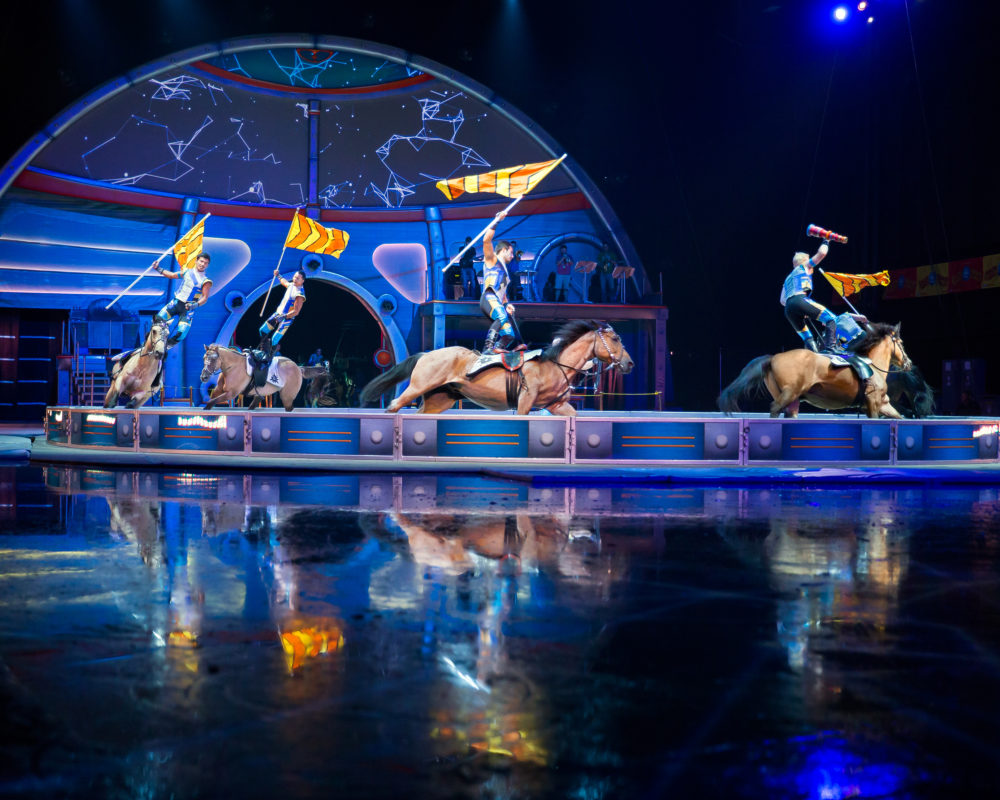Lions and Tigers and a Big Goodbye
Ready to pack it in after 146 years, Ringling Bros. brings its show to Barclays Center one more time. What killed the circus business?
The elephants were gone, but the lions were kept on board for the final shows (Photo credit: Copyright ©2014, Feld Entertainment, Inc. All Rights Reserved. Used with Permission from Feld Entertainment)
Brooklyn dwellers dreaming of quitting their jobs and running away to the circus will have to find another escape.
The circus is dead.
In January, the Ringling Bros. and Barnum & Bailey circus announced that the current season of their self-proclaimed Greatest Show on Earth would be its last. The reason, of course, was business. Isn’t it always? After years of conflict with PETA and other animal rights organizations, the 146-year-old institution removed—some say, set free—the live elephants used in the shows. But one step forward for animal safety is apparently two steps back on the balance sheet. The kids stopped coming.
In a statement, Kenneth Feld, CEO of Feld Entertainment, the parent company of Ringling Bros. and Barnum & Bailey said, “Ringling Bros. ticket sales have been declining, but following the transition of the elephants off the road, we saw an even more dramatic drop. This, coupled with high operating costs, made the circus an unsustainable business for the company.”

The show at Barclays, Out of This World, takes place on an “ice planet” (Photo credit: Copyright ©2014, Feld Entertainment, Inc. All Rights Reserved. Used with Permission from Feld Entertainment)
The struggles seem obvious in hindsight. Forbes estimated last year that only 15% of Feld Entertainment’s estimated $1.3 billion in revenue came from the circus, with much of the revenue coming from its other live entertainment properties. As Feld told Forbes, “I don’t think people view the circus in the same way [today], because everything progresses. … The circus grew up in a time when there was no television and very little entertainment.”
This is true—the circus act seems downright quaint compared to other more technologically savvy ploys for attention. This explains the latest incarnation, called Out of This World, which is running through Friday at Barclays Center. The show features a foray to an ice planet, aliens engaged in snowball fights, unicyclists playing basketball, and enough ice skating to make you think you were back in Sochi. Perhaps the circus masters thought the only way to bring the classic pastime into the future is through more, more, more: more flashing lights, more stunts, more screens that remind you of the iPads left at home.
The Golden Days
But Ringling Bros. has always banked on providing hours of entertainment that had nothing to do with virtual reality. No smokescreens. Before Cirque du Soleil, you could watch performers fling themselves off trapezes. Before YouTube videos of your uncle doing stupid stunts off the diving board, you’d watch clowns somersaulting. And, oh yes, there were the elephants. Back when movies were 10 cents a ticket and a live Instagram feed of your friend’s Rwandan safari was still 50 years away, you could see giant elephants, those total pros in a job they never asked for, circling round and round a stage.
And once upon a time, those same elephants were asked to bring their talents to Brooklyn. In 1884, showman P.T. Barnum herded 21 elephants across the Brooklyn Bridge to demonstrate its strength and prove to the public they wouldn’t plunge into the East River. Yes, this actually happened; there’s a New Yorker cover to prove it.
Madison Square Garden was the typical New York home for Ringling Bros., but more recently they’ve been stopping by Barclays Center during Ringling’s round-the-country tour. The vast space is perfect for the high-wire acts; the shrieks of excited children echo around the stadium. That was the scene Tuesday night, halfway through the final Brooklyn run. (The very last show will be May 21 at the Nassau Veterans Memorial Coliseum.)

The “Cossack Riders” team perform feats of skill and daring at high speed in a tiny ring (Photo credit: Copyright ©2014, Feld Entertainment, Inc. All Rights Reserved. Used with Permission from Feld Entertainment)
PETA protesters stood outside Barclays with flyers showing images of tigers in cages. “Please don’t pay for animal abuse!” one told the hundreds of parents and kids streaming through the doors. And they were paying a pretty penny: tickets for the circus range from $15 to over $100. That’s not to mention all the baubles inside for purchase: a plush leopard with cub ($26), an elephant stein ($15), face painting ($15), and of course the requisite popcorn ($9).
So the circus appeared to be raking in some money. Barclays was reasonably full, save for some empty swaths of seats on the upper decks.
During the show, the push and pull between the old-world circus and the future was evident. A tamer coerced 12 lions and tigers to sit, stand, and nuzzle him. (When he tapped a lioness’s rear, the kid behind me yelled, “He just smacked her!”) And then we all journeyed to an “ice planet.” When a clown stood atop an extremely perilous-looking telephone pole that reached up to the mezzanine, I could only think of Lady Gaga flying through the air at the Super Bowl, and how anesthetized we now are to shock and awe.
Last Animals in the Ring
At intermission a voice came over the speaker saying Ringling Bros. is dedicated to saving endangered species. That in the wild it’s becoming more difficult for big cats to survive. That they’re working with organizations in their native lands. That if you’ve enjoyed seeing their “animal ambassadors,” you, too, can raise money through conservation efforts.
Then we all watched a trapeze artist attempt a quadruple somersault, miss an outstretched hand, and fall many feet into the safety of a net. Later, llamas, goats, donkeys, two enormous pigs and dogs were herded out to perform tricks. A kangaroo hopped three loops around a ring and was herded back in its cage. The main conflict in the Out of This World story was the ringmaster fighting with a queen over a telescope, but it was hard to follow the narrative when there are 20 stories happening at once.
It’s easy to admire the energy the performers bring to the stage and still be stunned to see live animals bowing and jumping where the Brooklyn Nets dribble a ball during the other months of year. There’s little reason to be nostalgic for the circus’s early days that put even more of an emphasis on live animal tricks. Nearly everyone can agree these creatures are better off in the wild; instead, it’s interesting to note how the circus—something that was stuck to the cultural firmament as firmly as elephant dung to the sole of your shoe—suddenly became phased out, obsolete after almost 150 years.
An Encore on the Big Screen
Or perhaps it hasn’t. On a recent rainy February afternoon, a few blocks from Barclays, the neighborhood of Fort Greene was swarmed with trailers, craft services and outdoor lighting set-ups. The controlled chaos was for the upcoming film musical The Greatest Showman, starring Hugh Jackman as Ringling Bros. founder P.T. Barnum. It’s a big, glossy affair with songs by La La Land darlings Benj Pasek and Justin Paul, and Zac Efron and Michelle Williams are on the call sheet.
When the film hits theaters in December, a new generation will get a taste of an old-time entertainment. Perhaps the circus isn’t dead after all. Perhaps all it needed was a different screen, a new leading man—and to render its animals in CGI.

Contortionists appear throughout the inter-galactic adventure (Photo credit: Copyright ©2014, Feld Entertainment, Inc. All Rights Reserved. Used with Permission from Feld Entertainment)













